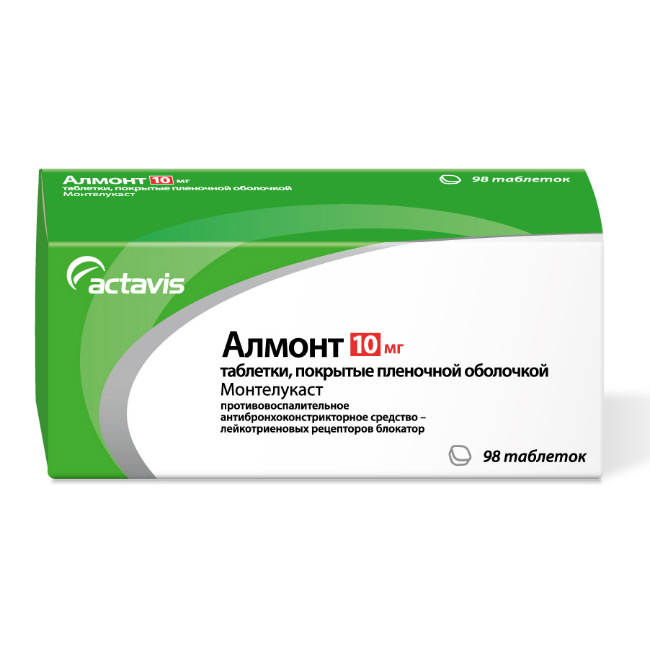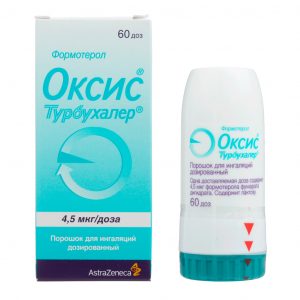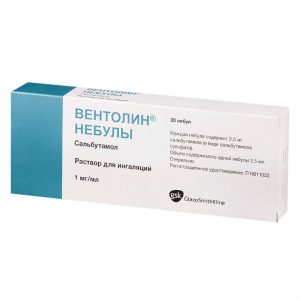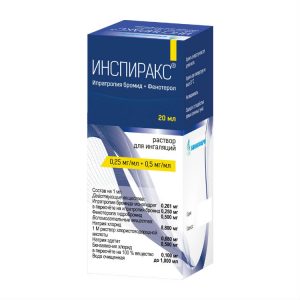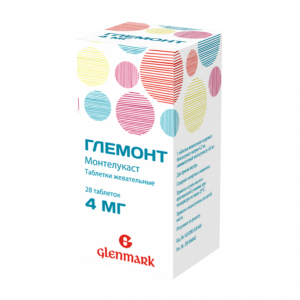Description
Pharmacological action of
Pharmacotherapeutic group: Anti-inflammatory anti-bronchoconstrictor agent – leukotriene receptor
ATX blocker:
R.03.DC03 Montelukast
4 strong cells, LTL4 including mast cells and eosinophils. These important pro-asthmatic mediators bind to cysteinyl-leukotriene receptors (CysLT), which are present in the human airways and are responsible for the reaction of bronchospasm, sputum production, vascular permeability and an increase in the number of eosinophils.
Montelukast is an orally active compound that has great affinity and selectivity for CysLT1 receptors. Montelukast in a dose of less than 5 mg stops the bronchospasm induced by inhalation LTD4. The bronchodilating effect is observed within 2 hours after oral administration. The bronchodilating effect of beta2-adrenergic agonists is enhanced when taking montelukast.
Montelukast inhibits both the early and late stages of bronchospasm caused by exposure to antigens. Montelukast reduces the number of eosinophils in peripheral blood in adults and children, and also significantly reduces the number of eosinophils in the airways.
In patients with hypersensitivity to acetylsalicylic acid receiving inhaled and / or oral glucocorticosteroids (GCS), the addition of montelukast to therapy provides better disease control.
Pharmacokinetics:
Absorption
After oral administration, montelukast is rapidly and almost completely absorbed. In adult patients, after taking chewable tablets at a dose of 5 mg on an empty stomach, the maximum plasma concentration (Cmax) is reached after 2 hours. The average bioavailability is 73%, this value decreases to 63% when taking Montelukast with food.
After taking chewable tablets at a dose of 4 mg on an empty stomach in patients aged 2 to 5 years, Cmax is achieved after 2 hours. The average value of Cmax in this group of patients is 66% higher, and the average value of Cmax is lower than the same value in adults when taking film-coated tablets at a dose of 10 mg.
Distribution of
The binding of montelukast to plasma proteins is more than 99%. The distribution volume at equilibrium is on average 8-11 liters. Preclinical studies have revealed minimal penetration of montelukast across the blood-brain barrier. 24 hours after administration, the concentration of montelukast is minimal in other tissues.
Metabolism
Montelukast is extensively metabolized in the liver. When used in therapeutic doses, the concentration of montelukast metabolites in plasma in equilibrium in adults and children is not determined.
In vitro studies have shown that P450 cytochrome isoenzymes (3A4, 2A6 and 2C9) are involved in the process of montelukast metabolism. however, in therapeutic concentrations, montelukast does not inhibit cytochrome P450 isoenzymes: 3A4, 2C9, 1A2, 2A6, 2C19 and 2D6. Metabolites have a minor therapeutic effect of montelukast.
Excretion
The half-life of montelukast in young healthy adult volunteers is from 2.7 to 5.5 hours. Plasma clearance of montelukast in healthy adult volunteers is an average of 45 ml / min. After oral administration of montelukast, 86% of the total amount is excreted through the intestines within 5 days and less than 0.2% through the kidneys, which, along with data on its bioavailability, confirms the excretion of montelukast and its metabolites mainly with bile.
Pharmacokinetics in special cases
The pharmacokinetics of montelukast in women and men is the same.
In elderly patients or patients with mild to moderate hepatic insufficiency, dosage adjustment of montelukast is not required.
The pharmacokinetics of montelukast in patients with renal failure have not been evaluated. Since montelukast and its metabolites are not excreted by the kidneys, dose adjustment in this category of patients is not required.
There is no data on the nature of the pharmacokinetics of montelukast in patients with severe hepatic impairment (more than 9 points on the Child-Pugh scale).
When taking high doses of montelukast (20 and 60 times the recommended dose for adults), a decrease in theophylline concentration in blood plasma is observed. When taking montelukast in recommended doses of 10 mg once a day, this effect is not observed.
Indications
Prevention and long-term treatment of asthma in children, including:
prevention of day and night symptoms of the disease (for children from 2 years of age and older)
treatment of bronchial asthma in patients with hypersensitivity to acetylsalicylic acid (for children from 6 years and older)
prevention of bronchospasm caused by physical exertion (for children from 2 years of age and older).
Relief of symptoms of seasonal and perennial allergic rhinitis in children from 2 years.
Contraindications
Hypersensitivity to the active or any auxiliary substance of the drug
children under 2 years of age (for a dosage of 4 mg) and up to 6 years of age (for a dosage of 5 mg)
patients with rare hereditary diseases: galactose intolerance, lactase deficiency or glucose-galactose malabsorption
phenylketonuria (contains aspartame).
Special instructions
The drug Almont is not recommended for the treatment of acute attacks of bronchial asthma. Patients with asthma are advised to always have emergency medications with them. When an acute attack occurs, short-acting inhaled betag-adrenomimetics should be used. Patients should consult their doctor as soon as possible if they need more inhalation of short-acting beta-adrenomimetics than usual.
Do not abruptly replace Almont with inhaled or oral corticosteroids. Missing data proving the possibility of reducing the dose of oral corticosteroids while taking montelukast.
In rare cases, patients who receive anti-asthma drugs, including montelukast, may develop systemic eosinophilia, which is sometimes accompanied by clinical signs of vasculitis, the so-called Charge-Strauss syndrome, a condition that is eliminated by taking systemic corticosteroids.
These cases are usually associated with dose reduction or discontinuation of oral corticosteroids therapy. It is impossible to exclude or establish the likelihood that antagonists of leukotriene receptors may be associated with the development of Charge-Strauss syndrome.
Therefore, doctors should be warned about the possibility of eosinophilia, a vascular rash, an increase in the severity of pulmonary symptoms, heart complications and / or neuropathy in patients. Patients who develop the above symptoms need to be re-examined and their treatment regimen reviewed.
Treatment with Almont does not prevent the development of bronchospasm in patients with hypersensitivity to acetylsalicylic acid when using acetylsalicylic acid and other non-steroidal anti-inflammatory drugs.
Almont contains aspartame, a source of phenylalanine. This drug may be harmful to patients with phenylketonuria.
The drug contains lactose monohydrate and should not be taken by patients with rare hereditary diseases: galactose intolerance, lactase deficiency or glucose-galactose malabsorption.
Impact on the ability to drive vehicles and mechanisms
Generally Montelukast does not affect the ability to drive vehicles or work with other mechanisms, but very rarely drowsiness and dizziness were noted in some patients, when these signs appear, patients are not recommended to drive vehicles and engage in other activities that require concentration and speed of psychomotor reactions.
Composition
1 film-coated tablet contains: active substance:
montelukast 10.00 mg (as montelukast sodium 10.40 mg)
excipients:
core – microcrystalline cellulose, type 102 89.30 mg, hyprolose 4.00 mg, croscarmellose sodium 6.00 mg, lactose monohydrate 89.30 mg, magnesium stearate 1.00 mg
film coat – Opadry II Beige 31F27012 (lactose monohydrate 1.440 mg, hypromellose 15cP 1.120 mg, titanium dioxide 1.011 mg, macrogol 4000 0.400 mg, dye iron oxide yellow 0.026 mg, dye iron oxide red 0.003 mg) 4.0 city
Dosage and administration of
The therapeutic effect of ALMONT, which allows controlling asthma symptoms, is achieved within 24 hours after administration. The patient is recommended to continue taking the drug, both during periods of controlled course of bronchial asthma, and during an exacerbation of bronchial asthma.
ALMONT should not be taken in conjunction with other drugs containing the same active substance – montelukast.
Elderly patients, patients with renal failure, and patients with mild to moderate hepatic insufficiency, special dose selection is not required.
No dose adjustment is required based on patient gender.
There is no data on the use of montelukast in patients with severely impaired liver function.
ALMONT can be added to the patient’s treatment with bronchodilators and inhaled corticosteroids.
Inhaled GCS: ALMONT can be prescribed for the treatment of asthma as an additional therapy for patients in whom inhaled GCS and short-acting beta-adrenergic agonists do not provide the necessary clinical control of the disease. The drug ALMONT can not be abruptly replaced by treatment with inhaled GCS.
For the treatment of patients from 2 to 15 years, another dosage form of the drug is available – chewable tablets.
Side effects
Infectious and parasitic diseases: upper respiratory tract infections.
Disorders from the blood and lymphatic system: increased tendency to bleeding, thrombocytopenia.
Immune system disorders: hypersensitivity reactions, including anaphylaxis, eosinophilic liver infiltration.
Mental disorders: pathological dreams, including nightmares, hallucinations, insomnia, somnambulism, irritability, anxiety, anxiety, agitation, including aggressive behavior or hostility, tremors, depression, disorientation, suicidal thoughts and behavior (suicidality).
Disorders of the nervous system: headache, dizziness, drowsiness, paresthesia / hypesthesia, convulsions.
Disorders of the heart: palpitations.
Disorders of the respiratory system, chest and mediastinal organs: nosebleeds.
Disorders of the gastrointestinal tract: diarrhea, dry mouth, dyspepsia, nausea, vomiting, abdominal pain, pancreatitis.
Disorders of the liver and biliary tract: increased activity of alanine aminotransferase and aspartate aminotransferase, hepatitis (including cholestatic, hepatocellular and mixed liver lesions).
Disorders of the skin and subcutaneous tissues: angioedema, tendency to hematomas, urticaria, pruritus, rash, erythema nodosum, erythema multiforme.
Disorders of the musculoskeletal and connective tissue: arthralgia, myalgia, including muscle cramps.
General disorders and disorders at the injection site: asthenia / fatigue, malaise, swelling, pyrexia, thirst.
In very rare cases, during the treatment with montelukast, the development of Charge-Strauss syndrome has been reported (see section Special instructions).
Overdose
Symptoms of drug overdose in patients with chronic bronchial asthma when used in a dose exceeding 200 mg per day for 22 weeks and at a dose of 900 mg per day for 1 week were not detected.
There are reports of an acute overdose of montelukast (when taken at least 1 g per day) in the post-marketing period and in clinical studies in adults and children.
Clinical and laboratory data indicate that the safety profile of the drug in children, adults and elderly patients is consistent. The most common symptoms were thirst, drowsiness, vomiting, psychomotor agitation, headache and abdominal pain. Treatment: symptomatic therapy.
Shelf life
3 years.
Terms and conditions
prescription
The dosage form of
tablet
Prescribed
For the children prescribed by the doctor, Children over 15 years old, Adults doctor’s prescription
Indications
Nasmork, bronchospasm, Bronhialynaya asthma
Actavis Ltd., Iceland i
